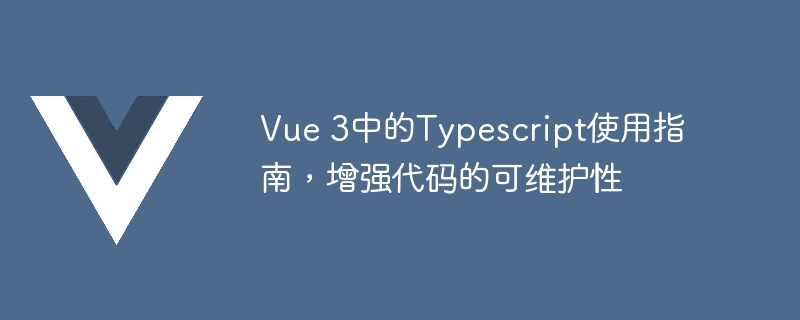Home >Web Front-end >Vue.js >Typescript usage guide in Vue 3 to enhance code maintainability
Typescript usage guide in Vue 3 to enhance code maintainability
- 王林Original
- 2023-09-09 08:27:281338browse

Typescript usage guide in Vue 3 to enhance code maintainability
Introduction:
In Vue 3, the use of Typescript has become a must for developers A topic that is widely concerned and respected. By combining with the Vue framework, Typescript can provide our code with stronger type checking and code intelligence prompts, thereby enhancing the maintainability of the code. This article will introduce how to use Typescript correctly in Vue 3 and demonstrate its powerful features through code examples.
1. Configure Typescript support for Vue 3 project
First, we need to add support for Typescript to the Vue 3 project. When creating a Vue project, we can choose to use the Vue CLI to automatically configure the Typescript environment. If you already have an existing Vue project, you can also add Typescript support manually.
-
Create a Typescript project using Vue CLI
Open the command line tool and execute the following command to install Vue CLI:npm install -g @vue/cli
Create a new Vue project and select Use Typescript:
vue create my-project
Then select "Manually select features" and check the "TypeScript" option.
-
Manually add Typescript support
If you already have an existing Vue project, you can manually add Typescript support. First, execute the following command in the root directory of the project to install Typescript:npm install --save-dev typescript
Then, create a new tsconfig.json file and configure the Typescript compilation options:
{ "compilerOptions": { "target": "esnext", "module": "esnext", "strict": true, "jsx": "preserve", "sourceMap": true, "resolveJsonModule": true, "esModuleInterop": true, "lib": ["esnext", "dom"], "types": ["node", "vite/client"] }, "include": ["src/**/*.ts", "src/**/*.d.ts", "src/**/*.vue", "tests/**/*.ts", "tests/**/*.tsx"], "exclude": ["node_modules"] }In tsconfig.json , we specified the compilation target as esnext, configured the strict mode of type checking (strict: true), and added some commonly used class libraries and type declarations.
2. Using Typescript in Vue 3 projects
- Using Typescript in single-file components
In the single-file component of Vue 3, we can Use thee7a8c58ab982b920d50c74fc26d408552cacc6d41bbb37262a98f745aa00fbf0tag to specify the use of Typescript to write logic code. Here is a simple example:
<template>
<div>{{ message }}</div>
</template>
<script lang="ts">
export default {
data() {
return {
message: 'Hello, Vue!'
};
}
}
</script>- Type declarations and interfaces
Typescript's powerful type system is one of its greatest features. We can use type declarations and interfaces to clarify the types of data and functions and provide better code hints and maintainability. The following is a sample code using interface and type declaration:
interface User {
name: string;
age: number;
}
function getUserInfo(user: User): string {
return `Name: ${user.name}, Age: ${user.age}`;
}
const user: User = {
name: 'John',
age: 25
};
console.log(getUserInfo(user));In the above code, we define a User interface, which contains two attributes: name and age. Then, we wrote a getUserInfo function that accepts a User object as a parameter and returns a string. Finally, we create a User object named user and pass it to the getUserInfo function for processing.
- Props and prototype properties of components
In Vue 3 components, we can use Props and prototype properties to define the input and output of the component. By declaring types in a component's Props, we can get better intellisense and type checking when writing code. Here is a sample code:
<template>
<div>{{ message }}</div>
</template>
<script lang="ts">
import { defineComponent, PropType } from 'vue';
interface Props {
name: string;
age: number;
}
export default defineComponent({
props: {
name: {
type: String as PropType<Props['name']>,
required: true
},
age: {
type: Number as PropType<Props['age']>,
default: 18
}
},
data() {
return {
message: `Name: ${this.name}, Age: ${this.age}`
};
}
});
</script>In the above code, we first imported the defineComponent and PropType methods. Then, we defined a Props interface, which contains two attributes: name and age. Next, in the props option of the component, we specify the type of the name attribute as the name attribute type of the Props interface through PropTypeba77af5be389e455f940ca78492365e5. Finally, we render the component's template based on the properties in the props option.
Conclusion:
In Vue 3, using Typescript can provide our code with stronger type checking and code intelligent prompt functions, thereby enhancing the maintainability of the code. This article describes how to configure Typescript support for Vue 3 projects, as well as sample code for correctly using Typescript in Vue 3 projects. I hope this article helps you use Typescript in Vue 3.
The above is the detailed content of Typescript usage guide in Vue 3 to enhance code maintainability. For more information, please follow other related articles on the PHP Chinese website!

